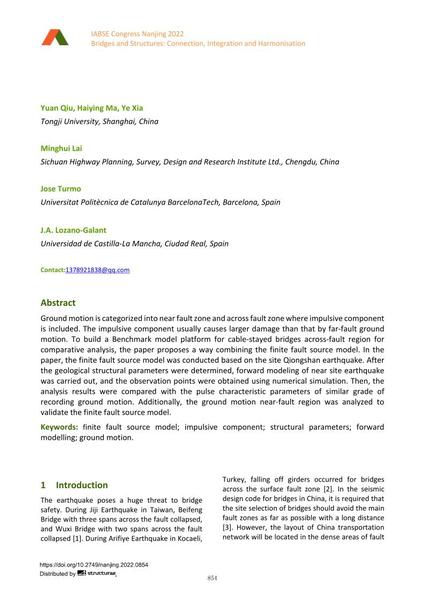Finite Fault Source Model for Ground Motion near Fault Zone

|
|
|||||||||||
Détails bibliographiques
| Auteur(s): |
Yuan Qiu
(Tongji University, Shanghai, China)
Haiying Ma Ye Xia (Tongji University, Shanghai, China) Minghui Lai (Sichuan Highway Planning, Survey, Design and Research Institute Ltd., Chengdu, China) José Turmo J. A. Lozano-Galant (Universidad de Castilla-La Mancha, Ciudad Real, Spain) |
||||
|---|---|---|---|---|---|
| Médium: | papier de conférence | ||||
| Langue(s): | anglais | ||||
| Conférence: | IABSE Congress: Bridges and Structures: Connection, Integration and Harmonisation, Nanjing, People's Republic of China, 21-23 September 2022 | ||||
| Publié dans: | IABSE Congress Nanjing 2022 | ||||
|
|||||
| Page(s): | 854-862 | ||||
| Nombre total de pages (du PDF): | 9 | ||||
| DOI: | 10.2749/nanjing.2022.0854 | ||||
| Abstrait: |
Ground motion is categorized into near fault zone and across fault zone where impulsive component is included. The impulsive component usually causes larger damage than that by far-fault ground motion. To build a Benchmark model platform for cable-stayed bridges across-fault region for comparative analysis, the paper proposes a way combining the finite fault source model. In the paper, the finite fault source model was conducted based on the site Qiongshan earthquake. After the geological structural parameters were determined, forward modeling of near site earthquake was carried out, and the observation points were obtained using numerical simulation. Then, the analysis results were compared with the pulse characteristic parameters of similar grade of recording ground motion. Additionally, the ground motion near-fault region was analyzed to validate the finite fault source model. |
||||
| Copyright: | © 2022 International Association for Bridge and Structural Engineering (IABSE) | ||||
| License: | Cette oeuvre ne peut être utilisée sans la permission de l'auteur ou détenteur des droits. |
||||
